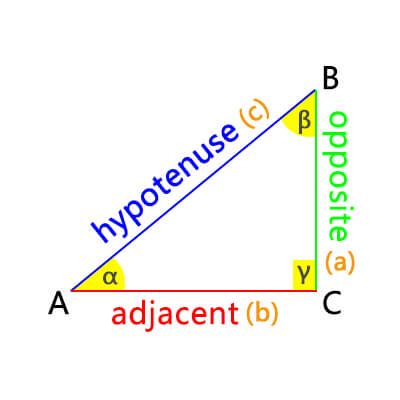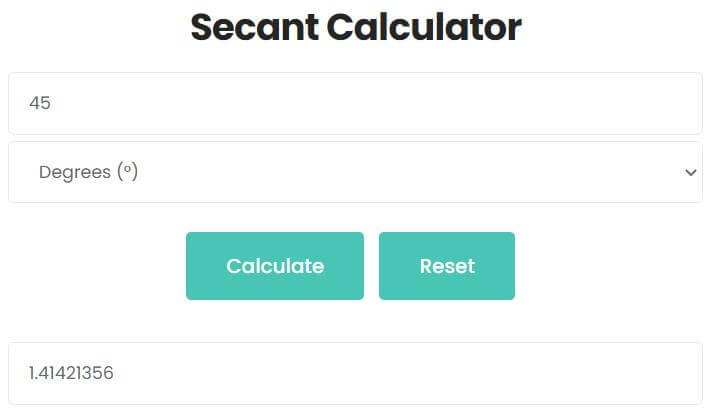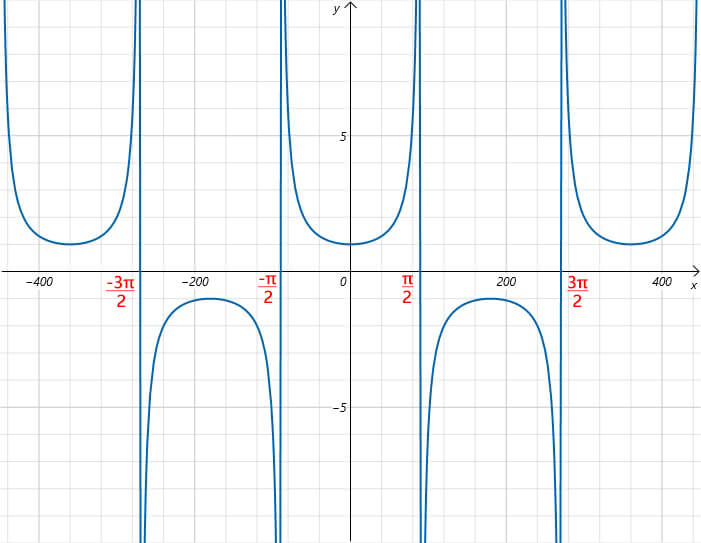Secant Calculator is a handy free online tool for calculating the secant of any given degree or radian.
What is secant?
Secant is one of the trigonometric functions that refers to the ratio of the hypotenuse of an acute angle to its adjacent side in a right triangle. The abbreviation for secant is sec.
 The secant formula is
The secant formula is
sec(θ) = hypotenuseadjacent
Obviously, this is the reciprocal of the cosine.
How to calculate secant?
There are two ways to calculate secant.
The first one is based on the length of the sides.
In this case, the side lengths can be substituted into the secant formula directly.
For example, the length of the hypotenuse of a right triangle is 5, and the length of the side adjacent to angle α is 3. What is the secant of angle α?
Substitute 3 and 5 into the secant formula
sec(α) = hypotenuseadjacent = 53
So, the secant of angle α is 53.
If you know the two sides of a right triangle. But these two sides are not the hypotenuse and the adjacent side. Then you can use the Pythagorean theorem to calculate the other side. Finally, use the secant formula to calculate.
The second is based on the degree of the angle.
In this case, it is simpler to just use a secant calculator (such as the one provided on this page). Enter the degrees and click Calculate to obtain the secant.
For instance, what is the secant of 45 degrees?
Enter the 45 into the input box and select degrees, then click Calculate button. As shown below, the secant of 45° is 1.41421356.
 Of course, there is also the most primitive method, refer to the secant table, and find the corresponding secant according to degrees or radians.
Of course, there is also the most primitive method, refer to the secant table, and find the corresponding secant according to degrees or radians.
| Degrees | Radians | Sec |
| 0° | 0 | 1 |
| 5° | π36 | 1.00381984 |
| 10° | π18 | 1.01542661 |
| 15° | π12 | 1.03527618 |
| 20° | π9 | 1.06417777 |
| 25° | 5π36 | 1.10337792 |
| 30° | π6 | 1.15470054 |
| 35° | 7π36 | 1.22077459 |
| 40° | 2π9 | 1.30540729 |
| 45° | π4 | 1.41421356 |
| 50° | 5π18 | 1.55572383 |
| 55° | 11π36 | 1.7434468 |
| 60° | π3 | 2 |
| 65° | 13π36 | 2.36620158 |
| 70° | 7π18 | 2.9238044 |
| 75° | 5π12 | 3.86370331 |
| 80° | 4π9 | 5.75877048 |
| 85° | 17π36 | 11.47371325 |
| 95° | 19π36 | -11.47371325 |
| 100° | 5π9 | -5.75877048 |
| 105° | 7π12 | -3.86370331 |
| 110° | 11π18 | -2.9238044 |
| 115° | 23π36 | -2.36620158 |
| 120° | 2π3 | -2 |
| 125° | 25π36 | -1.7434468 |
| 130° | 13π18 | -1.55572383 |
| 135° | 3π4 | -1.41421356 |
| 140° | 7π9 | -1.30540729 |
| 145° | 29π36 | -1.22077459 |
| 150° | 5π6 | -1.15470054 |
| 155° | 31π36 | -1.10337792 |
| 160° | 8π9 | -1.06417777 |
| 165° | 11π12 | -1.03527618 |
| 170° | 17π18 | -1.01542661 |
| 175° | 35π36 | -1.00381984 |
| 180° | π | -1 |
| 185° | 37π36 | -1.00381984 |
| 190° | 19π18 | -1.01542661 |
| 195° | 13π12 | -1.03527618 |
| 200° | 10π9 | -1.06417777 |
| 205° | 41π36 | -1.10337792 |
| 210° | 7π6 | -1.15470054 |
| 215° | 43π36 | -1.22077459 |
| 220° | 11π9 | -1.30540729 |
| 225° | 5π4 | -1.41421356 |
| 230° | 23π18 | -1.55572383 |
| 235° | 47π36 | -1.7434468 |
| 240° | 4π3 | -2 |
| 245° | 49π36 | -2.36620158 |
| 250° | 25π18 | -2.9238044 |
| 255° | 17π12 | -3.86370331 |
| 260° | 13π9 | -5.75877048 |
| 265° | 53π36 | -11.47371325 |
| 275° | 55π36 | 11.47371325 |
| 280° | 14π9 | 5.75877048 |
| 285° | 19π12 | 3.86370331 |
| 290° | 29π18 | 2.9238044 |
| 295° | 59π36 | 2.36620158 |
| 300° | 5π3 | 2 |
| 305° | 61π36 | 1.7434468 |
| 310° | 31π18 | 1.55572383 |
| 315° | 7π4 | 1.41421356 |
| 320° | 16π9 | 1.30540729 |
| 325° | 65π36 | 1.22077459 |
| 330° | 11π6 | 1.15470054 |
| 335° | 67π36 | 1.10337792 |
| 340° | 17π9 | 1.06417777 |
| 345° | 23π12 | 1.03527618 |
| 350° | 35π18 | 1.01542661 |
| 355° | 71π36 | 1.00381984 |
| 360° | 2π | 1 |
Secant graph and range
Now, we will combine the secant curve to summarize the properties of the secant.

- Domain – The domain of the secant function is all values except kπ + π2. Here, k is an integer.
- Range – The absolute value of the secant is greater than or equal to 1, that is, secant is less than or equal to -1 or greater than or equal to 1.
- Period – The smallest period of secant is 2π. sec(θ) = sec(θ + 2π)
- Even function – Since sec(θ) = sec(-θ), secant is an even function.
Furthermore, in different quadrants of the coordinate axis, the secant ranges are also different. Secant comparisons for the four quadrants are listed below.
| Quadrant | Degrees | Radians | Sign | Sec Values | Monotonicity |
| 1 | 0° < θ < 90° | 0 < θ < π2 | + | sec(θ) > 1 | Ascending |
| 2 | 90° < θ < 180° | π2 < θ < π | – | sec(θ) < -1 | Ascending |
| 3 | 180° < θ < 270° | π < θ < 3π2 | – | sec(θ) < -1 | Decreasing |
| 4 | 270° < θ < 360° | 3π2 < θ < 2π | + | sec(θ) > 1 | Decreasing |
Other calculations for secant
1. Secant derivative
The derivative of secant is equal to tangent times secant. Its derivation process is as follows
(sec(θ))’
= (1cos(θ))’
= -cos(θ)’cos2(θ)
= sin(θ)cos2(θ)
= tan(θ) * 1cos(θ)
= tan(θ) * sec(θ)
2. Inverse secant
Within a certain range, the inverse secant function is arcsecant, denoted as arcsec, or sec-1. It is a type of inverse trigonometric function. The arcsecant is used to find the angle value from the ratio of the hypotenuse side to the adjacent side.
sec(0) = 1
sec-1(1) = arcsec(1) = 0
3. Reciprocal secant
The reciprocal of secant is cosine, which is equal to the ratio of its adjacent to its hypotenuse side. The abbreviation is cos.
1sec(θ) = cos(θ)
How to use this secant calculator
The secant calculator is very easy to use, three steps:
First, enter degrees or radians;
Second, choose the type, degrees or radians.
Finally, click Calculate button to get the secant answer, or click Reset button to start a new calculation.
FAQS
- Q: What is 1/secant?A: 1secant is the reciprocal of secant, which is the cosine.
- Q: What is secant 0?A: Secant 0 is equal to 1.
- Q: Is secant odd or even?A: The secant function is an even function.
- Q: What is secant over tangent?A: The secant over tangent is cosecant. The abbreviation is csc. The derivation process is as follows
sec(θ)tan(θ)
= 1/cos(θ)sin(θ)/cos(θ)
= 1cos(θ) * cos(θ)sin(θ)
= 1sin(θ)
= csc(θ)
- Q: How to enter radians?A: If it is a number, just input it directly. If it is combined with π, such as π/2, 3π/4, etc. Copy and paste π, or type pi. Then enter it in the above format.
- Q: In which quadrant is secant negative? And in which quadrant is it positive?A: As we summarized above, secant is positive in the first and fourth quadrants and negative in the second and third quadrants.
Latest Calculators
Standard Form to Slope-Intercept Form Calculator
Slope Intercept Form Calculator
Slope Calculator: Calculate Slope, X-Intercept, Y-Intercept
Reciprocal of Complex Number Calculator
Conjugate Complex Number Calculator
Modulus of Complex Number Calculator
Profit Percentage Calculator: Calculate Your Profitability Easily
Attendance and Absence Percentage Calculator
Trigonometric Functions
Arccsc Calculator – Find the Exact Value of Inverse Cosecant
Arcsec Calculator – Find the Exact Value of Inverse Secant
Arccot Calculator – Find the Exact Value of Inverse Cotangent
Arctan Calculator – Find the Exact Value of Inverse Tangent
Inverse Cosine Calculator – Find The Exact Value of Arccos
Inverse Sine Calculator – Find The Exact Value of Arcsin
Inverse Trigonometric Functions Calculator
Trigonometric Functions Conversion Calculator
Trig Calculator – Find 6 Trigonometric Functions by Angles or Sides